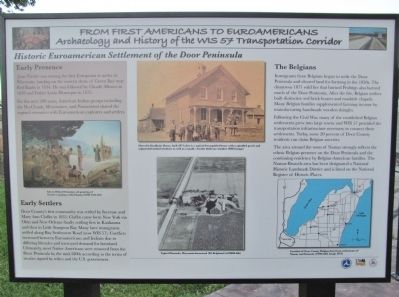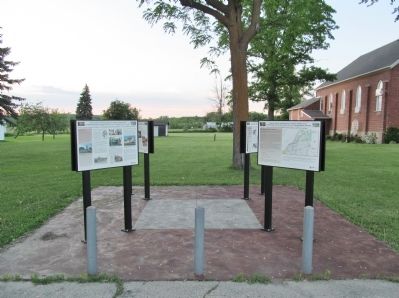Namur in Door County, Wisconsin — The American Midwest (Great Lakes)
Historic Euroamerican Settlement of the Door Peninsula
From First Americans to Euroamericans
— Archaeology and History of the WIS 57 Transportation Corridor —
Inscription.
Early Presence
Jean Nicolet was among the first Europeans to arrive in Wisconsin, landing on the eastern shore of Green Bay near Red Banks in 1634. He was followed by Claude Allouez in 1639 and Father Louis Hennepin in 1675.
For the next 200 years, American Indian groups including the Ho-Chunk, Menominee, and Potawatomi shared the regions resources with Euroamerican explorers and settlers.
Early Settlers
Door County’s first community was settled by Increase and Mary Ann Claflin in 1835. Claflin came form New York via Ohio and New Orleans finally settling first in Kaukauna and then in Little Sturgeon Bay. Many later immigrants settled along Bay Settlement Road (now WIS 57). Conflicts increased between Euroamericans and Indians due to differing lifestyles and increased demand for farmland. Ultimately, most Native Americans were removed from the Door Peninsula by the mid-1800s according to the terms of treaties signed by tribes and the U.S. government.
The Belgians
Immigrants from Belgium began to settle the Door Peninsula and cleared land for farming in the 1850s. The disastrous 1871 wild fire that burned Peshtigo also burned much of the Door Peninsula. After the fire, Belgian settlers built distinctive red brick houses and roadside chapels. Many Belgian families supplemented farming income by manufacturing handmade wooden shingles.
Following the Civil War, many of the established Belgian settlements grew into large towns and WIS 57 provided the transportation infrastructure necessary to connect these settlements. Today, some 20 percent of Door County residents can claim Belgian ancestry.
The area around the town of Namur strongly reflects the ethnic Belgian presence on the Door Peninsula and the continuing residence by Belgian-American families. The Namur-Brussels area has been designated a National Historic Landmark District and is listed on the National Register of Historic Places.
logos of United States Department of Transportation, University of Wisconsin–Milwaukee, Wisconsin Department of Transportation
Erected 2012 by U.S. Department of Transportation, University of Wisconsin–Milwaukee, Wisconsin Department of Transportation.
Topics. This historical marker is listed in these topic lists: Exploration • Industry & Commerce • Native Americans • Settlements & Settlers. A significant historical year for this entry is 1634.
Location. 44° 44.064′ N, 87° 40.018′ W. Marker is in Namur, Wisconsin, in Door County. Marker is
on County Road DK east of County Road N, on the left when traveling east. Marker is immediately southwest of the Belgian Heritage Center, formerly Our Lady of the Snows Church. Touch for map. Marker is at or near this postal address: 1255 County Road DK, Brussels WI 54204, United States of America. Touch for directions.
Other nearby markers. At least 8 other markers are within 3 miles of this marker, measured as the crow flies. The Fire of 1871 and Williamsonville: A 19th Century Euroamerican Settlement in Door County (here, next to this marker); Architecture and History in the WIS 57 Project Area (here, next to this marker); Transportation Archaeology on the WIS 57 Project (here, next to this marker); Namur and the Norbertine Fathers: Community, Education, and Religion among Belgian-Americans (here, next to this marker); After the Fire: The Vandermissen Brickworks Site (here, next to this marker); The WIS 57 Reconstruction Project in Brown, Kewaunee, and Door Counties (here, next to this marker); Belgian Settlement in Wisconsin (within shouting distance of this marker); The Brussels Cemetery Grotto (approx. 2˝ miles away). Touch for a list and map of all markers in Namur.
More about this marker. photo, map, and painting captions, clockwise:
• Marcelin Baudhuin House, built 1871; this is a typical front-gabled house with a spindled porch and segmented arched windows as well as a small, circular bulls-eye window (WHS image)
• Location of Door County Belgian-American settlements of Namur and Brussels (UWM-ARL image 2012)
• Typical Brussels, Wisconsin farmstead (WI.BelgAmrCol.0289b.bib)
• Edwin Willard Deming s oil painting of Nicolet's landing at Red Banks (WHS 1942.487)
Also see . . .
1. Namur Belgian Heritage Foundation. (Submitted on January 13, 2015.)
2. Namur Belgian Heritage Foundation – Facebook. (Submitted on January 13, 2015.)
3. Namur Belgian-American District National Register Nomination. (Submitted on January 21, 2020, by William Fischer, Jr. of Scranton, Pennsylvania.)
Credits. This page was last revised on October 14, 2021. It was originally submitted on January 13, 2015, by Keith L of Wisconsin Rapids, Wisconsin. This page has been viewed 662 times since then and 25 times this year. Photos: 1, 2. submitted on January 13, 2015, by Keith L of Wisconsin Rapids, Wisconsin.

